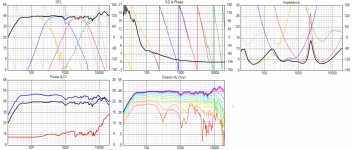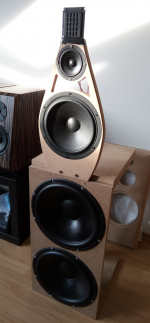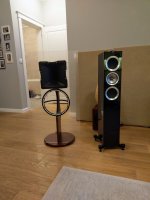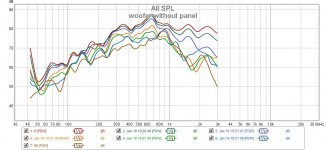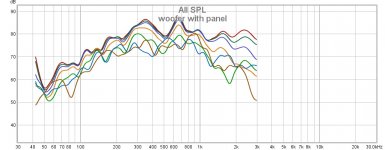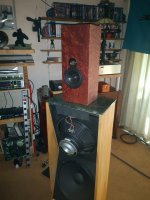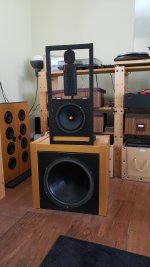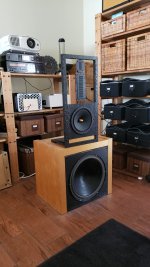You should look through the gainphile site that is linked to in post 15. You should also look at linkwitzlab.com. It is huge and much of it is technical, but it is one of the best source of info on dipoles.
As you might be noticing just from the replies to your question, there are many different ways of dealing with the bass issue in dipoles and there is a huge volume of discussion on the web about this. Designers use EQ, arrays, wide baffles, hybrids and other approaches. You would probably be helped by reading about the development process of a single speaker. Linkwitz documented the evolution of his flagship dipole speaker in great detail. Experimenting blindly might teach you a little but at some point if you really want to understand you are going to have to read the theory.
You would also learn a lot by building a preexisting dipole. Here is one with a small baffle:
Gainphile: S20-Z Compact Open Baffle using Zaph Kit
Thanks a lot !! I referred Linkwitzlab earlier... But his depth of complex mathematical explanation is sometimes hard to grasp. But yes... That's a huge source of knowledge !! Il visit again in depth.
Dipoles with narrow baffles seems to be extremely difficult to equalize and extremely sensible to room placement.
These are my speakers on audio show in Warsaw. There were four set of speakers in our DIY room. My baffle-less speakers were the most difficult to place. Moving nearby objects even a little bit changed behavior of midbass frequencies. Bass-reflex loudspeakers were much more forgiving.
Nearfield equalization doesn't work for baffle-less drivers. If baffle-less driver is equalized near field, the equalization is completely useless from listening position in my room. Don't be fooled by pretty "8" directivity of dipoles. They actually exhibit a flower like behavior with many-many petals.
On the plus side, imaging is really good. Speakers completely disappear. In my speakers horn section is vibroisolated from the midbass and doesn't move when playing. View attachment 800875
Wow !! Your setup is simply awesome to watch !!!!
And thanks a lot for the important suggestions that drivers with very less baffles are very hard to EQ !!! Il keep it in mind.
Ur setup is lovely !!!!
You aren't talking about EQing below the dipole peak?Dipoles with narrow baffles seems to be extremely difficult to equalize and extremely sensible to room placement.
Audfrknaveen, maybe little inspiration for you. I tried 4w open baffle constant directivity just for fun, ~3years ago. Fully passive. I have never finished that, as crossover was quite complex and parts count was huge. All LR4 filters. It took several proto baffles. After all experimentation, I found 2kHz area the most problematic, it was about finding balance between no baffle and at least some baffle to provide support for tweeter.
Attachments
You aren't talking about EQing below the dipole peak?
Yes. In my case the problematic region is about between 150 and 700Hz. Midbass plays from 100 to about 1200Hz.
I see, what driver is that? It sounds like you are attempting to go too low?.
It's Beyma 12mwnd
The problem is different. If I make the driver flat on axis, I take a measurement from listening position and get a wide dip between 200 and 600Hz. If I stand tall, I get a peak around 400Hz. If I move a bit to the side, peaks and deeps randomly move across the frequency response.
You could also try an L baffle, see:
Chill-Baffle speaker (L-baffle design)
Chill-Baffle2 speaker (L-baffle, full-range + woofer)
In the meantime, I am working on the third version with an Heil AMT on top and driven by Hypex Fusion DSP plate amps...
Fedde
Chill-Baffle speaker (L-baffle design)
Chill-Baffle2 speaker (L-baffle, full-range + woofer)
In the meantime, I am working on the third version with an Heil AMT on top and driven by Hypex Fusion DSP plate amps...
Fedde
Another interesting design with minimal baffle.
The Totem of Tone, an active 3-way dipole and active subwoofer
The Totem of Tone, an active 3-way dipole and active subwoofer
I like U frame myself. Multiples can be made to distribute around the room. Very nice bass as I recall.Yes....tried both options. With one phase there is zero bass. With reverse phase, there is bass. But nothing unique and spl is also not upto expectations. Then I built two individual H frames with those two drivers, and it was lot better than ripple.
As far as the physical construction of ripple is concerned, I did it reasonably good based on many online articles. Somehow didn't work as expected.
Hi all,
Please see the attached images.
Some DIY open baffles have large (in terms of width) baffles, but some people are able to manage with smallest baffle width possible.
When i say small, i mean relative to the size of the driver.
How are they able to manage with smallest baffle size (in terms of width) ?? For example, for a 15" driver, how to manage with a baffle width of 17 to 18"
One of the important functions of the baffle is to separate the rear waves and front waves. In that sense, large baffle if preferred. But with small baffles, how is the front and rear waves separation possible ??
And then there is another concept of acoustic off center to reduce the peaks, which is obviously not possible with baffles with small width.
I saw the JAMO at CES. It wasn't playing anything. I can't recall if they actually produced it, but the impression that I got was that they made it to be eye-catching and to get people to ask "what the heck is that?"
Back in the 90s, CES just hired pretty girls to achieve the same reaction, but that went out of style 20 years ago.
TLDR: I think the JAMO was mostly a conversation piece.
Linkwitz and Kreskovsky have researched this REALLY deeply, and if you look at their speakers, the baffles got smaller and smaller and smaler, year after year. I'm not an expert on dipoles, but as I understand it, you want a small baffle because the small baffle allows the speaker to work as a dipole to a higher frequency.
IE, if you use a baffle that's a foot wide, your speaker will only behave like a dipole up to a low frequency, and above that, it won't be dipole, it will be something else.
IE, if you use a baffle that's a foot wide, your speaker will only behave like a dipole up to a low frequency, and above that, it won't be dipole, it will be something else.
Not if you put a Heil AMT on top of the baffle...
I did a comparison between "no baffle" and 55 cm baffle using the same 12'' driver. I ordered a plexi wall for my baffle-less speakers:
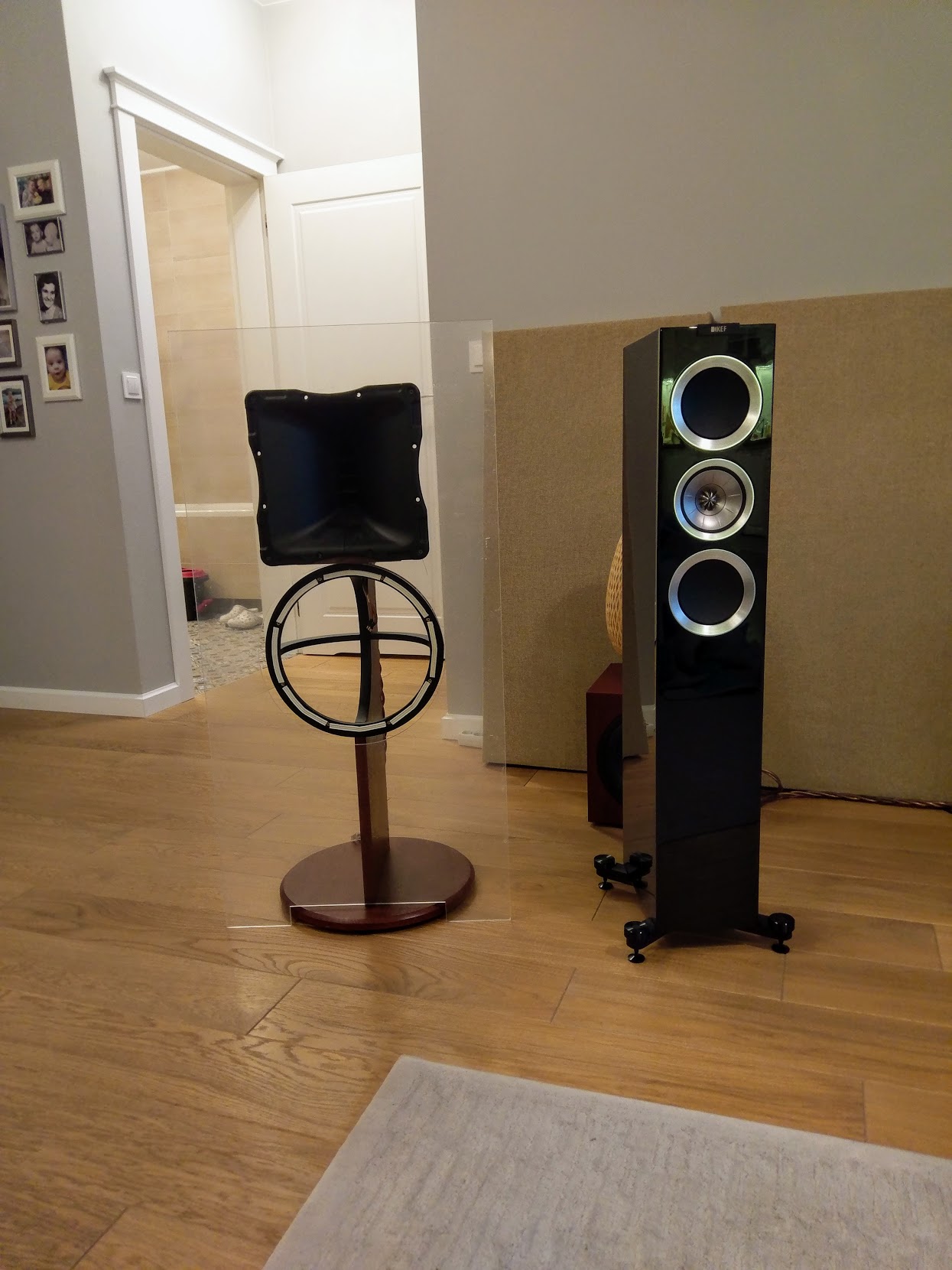
There is a sheet of transparent plexi in front of the speaker. The plexi doesn't touch the driver. It's right around it and doesn't vibrate because it's mounted to the horn which is vibroisolated from the woofer.
Here is a comparison of on-axis and off-axis responses from 0 to 90 degrees horizontally. In-room, mic is 1.5m to the speaker, at horn's height. The woofer is about 1m from the floor and 2m from ceiling. 1/6 smoothing, 1/6 FDW.

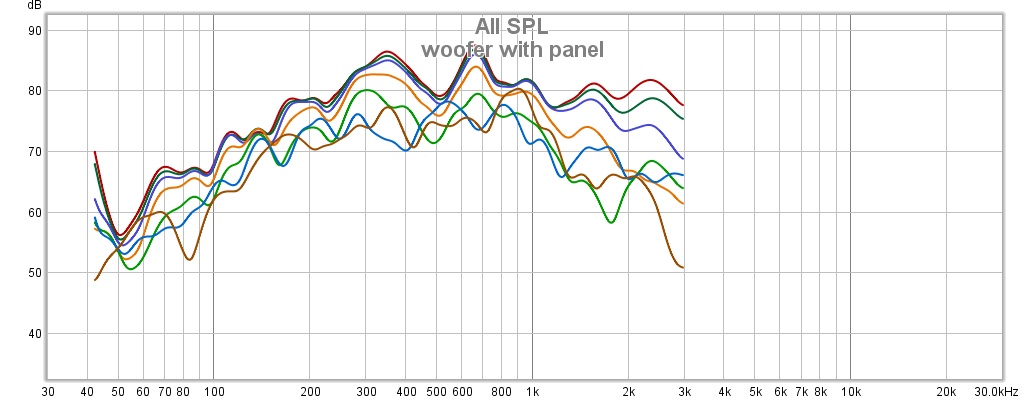
There is a sheet of transparent plexi in front of the speaker. The plexi doesn't touch the driver. It's right around it and doesn't vibrate because it's mounted to the horn which is vibroisolated from the woofer.
Here is a comparison of on-axis and off-axis responses from 0 to 90 degrees horizontally. In-room, mic is 1.5m to the speaker, at horn's height. The woofer is about 1m from the floor and 2m from ceiling. 1/6 smoothing, 1/6 FDW.
Attachments
Puppet, thank you. I actually did not finish them. This was just an excersise to see if it can be done, and passively. It seemed it can, just parts count was quite huge. Anyway, I still like that concept, and I would like to get back to it in future, with at least woofers crossed over in active + DSP.
Pida, that build looks great. Bet it sounds great, too.
I made a couple of open back W Frames, and am trying out different "head" units for them.Try this Gainphile: Dipole Bass Array.
Four 10" drivers per side will give you greater than 15" driver surface area.
Solid to the 40s, and no issues with a turntable.
Attachments
Smallest possible baffle is no baffle at all. At least for upper mid and tweeter.
For midbass, i would use small baffle.
For bass, i would not go naked, its a waste, normal U shape or H shape open baffle is perfect.
For midbass, i would use small baffle.
For bass, i would not go naked, its a waste, normal U shape or H shape open baffle is perfect.
Attachments
@xrk971
has worked on SLOB to solve the OB bass on a narrow baffle dilemma:https://www.diyaudio.com/community/threads/the-xsd-speaker.385717/
A possible SLOB variant design might allow a very narrow baffle. If using four 8" woofers the view from the back:
- the baffle being narrow has poor resistance to lateral displacements, so the driver arrangement needs to suppress lateral translational and rotational forces
- the stacking lowers the height
- the slots are reversed front to back from the usual
- the rear slot is wide and central
- the front slots are dual narrow lateral slots - hopefully the long wavelengths allows them to seamlessly combine but that the compromise for an elegant frontal profile
- Home
- Loudspeakers
- Multi-Way
- How to design open baffles with smallest possible baffle size
